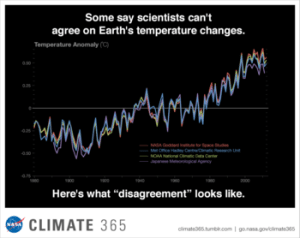It’s official: NOAA and NASA have confirmed that 2014 was the hottest year on record. Despite the fact of Arctic cold winters on the US east coast, the average earth surface temperature was the hottest on record. Those cold temperatures were more than made up for elsewhere.
The fact that the three hottest years on record are 2014, 2010 and 2005 points in the direction that climate change is indeed a reality, a reality that is only getting worse as time goes on.
The 10 warmest years have all occurred since 1997, a reflection of the relentless planetary warming that scientists say is a consequence of human activity. Climate change deniers have pointed to 1998 as the year they say the earth stopped warming. Despite the fact that 1998 was the hottest year on record up to that point, that record has since been broken … many times!
Oceans were unusually warm everywhere except Antarctica fueling extreme Pacific ocean storms. Since the year 2000 there have been seven major typhoons in the Philippines, the country most exposed to deadly storms in the world. These storms have cost between $193 million and $2.86 billion in damages and clean-up each.
The remarkable thing about 2014 is that the heat record did not occur during an El Nino year which is the type of weather system that usually produces heat records. The next time there is an El Nino, records will probably be blown away.
According to the New York Times:
[Scientists] expect the heat to get much worse over coming decades, but already it is killing forests around the world, driving plants and animals toextinction, melting land ice and causing the seas to rise at an accelerating pace.
“It is exceptionally unlikely that we
would be witnessing a record year of warmth, during a record-warm
decade, during a several decades-long period of warmth that appears to
be unrivaled for more than a thousand years, were it not for the rising
levels of planet-warming gases produced by the burning of fossil fuels,”
Michael E. Mann, a climate scientist at the Pennsylvania State
University, said in an email.
 As heat records continue to pile up, climate change deniers will have an increasingly tough time explaining their position. Berkely Earth
has shown that the rise in average world land temperatures is
approximately 1.5 degrees C in the past 250 years, and about 0.9 degrees
in the past 50 years.
As heat records continue to pile up, climate change deniers will have an increasingly tough time explaining their position. Berkely Earth
has shown that the rise in average world land temperatures is
approximately 1.5 degrees C in the past 250 years, and about 0.9 degrees
in the past 50 years.As a result of recent calculations, many scientists now say that sea levels are likely to rise perhaps three feet by 2100 — an increase that, should it come to pass, would pose a threat to coastal regions the world over. A rise of three feet would inundate low-lying lands in many countries rendering some areas uninhabitable. It would cause coastal flooding of the sort that now happens once or twice a century to occur every few years. It would cause much faster erosion of beaches, barrier islands and marshes. It would contaminate fresh water supplies with salt.
Coastal cities like New York, Miami, London, Cairo, Bangkok, Venice and Shanghai could be inundated. Many areas of the US east coast would be subject to punishing storm surges on a yearly basis. Melting ice in Greenland seems to be accelerating which is an ominous sign because, if Greenland’s ice disappears, that alone could raise sea levels worldwide by 20 feet. The fact that 2014 saw seven straight months of record high ocean temperatures from May to November bodes ill for polar glaciers.
Sea levels have varied by hundreds of feet in the past but that was before humans evolved.
With the waxing and waning of ice ages, driven by wobbles in the earth’s orbit, sea level has varied by hundreds of feet, with shorelines moving many miles in either direction. “We’re used to the shoreline being fixed, and it’s not,” said Robin E. Bell, a scientist at the Lamont-Doherty Earth Observatoryof Columbia University.
But at all times in the past, when the shoreline migrated, humans either had not evolved yet or consisted of primitive bands of hunter-gatherers who could readily move. By the middle of this century, a projected nine billion people will inhabit the planet, with many millions of them living within a few feet of sea level.
Melting glaciers will also affect the world’s fresh water supply.The Himalayas supply water to 1.5 billion of the earth’s people through three major rivers: the Indus, the Ganges and the Yangtze. Glaciers in the Andes Mountains supply the Amazon River, and glaciers in the Alps provide the water for the Rhine, the Rhone and the Danube. Shipping across Europe wouldn’t be possible without adequate water flows in these rivers.
 The
drought in California is the worst in over 1200 years. Record wildfires
were experienced in Washington State including the largest wildfire in
the state’s history with 400 square miles of land burned and 300
structures lost. Major floods and hurricanes occurred throughout the
world. 2015 promises more of the same.
The
drought in California is the worst in over 1200 years. Record wildfires
were experienced in Washington State including the largest wildfire in
the state’s history with 400 square miles of land burned and 300
structures lost. Major floods and hurricanes occurred throughout the
world. 2015 promises more of the same.Will Republicans provide the funds to deal with emergencies that extreme weather events will cause in the next two years while they are controlling Congress and to a large extent the fate of the nation? I don’t think so. Adaptation and mitigation will be ignored. The red states stand to lose the most as tornadoes wreak havoc in Tornado Alley. People there may be left to their own devices as Republicans in Congress, climate change deniers all, will also not be very charitable in putting up funds to assist those who have experienced weather related extreme events.
Source: San Diego Free Press
Nenhum comentário:
Postar um comentário